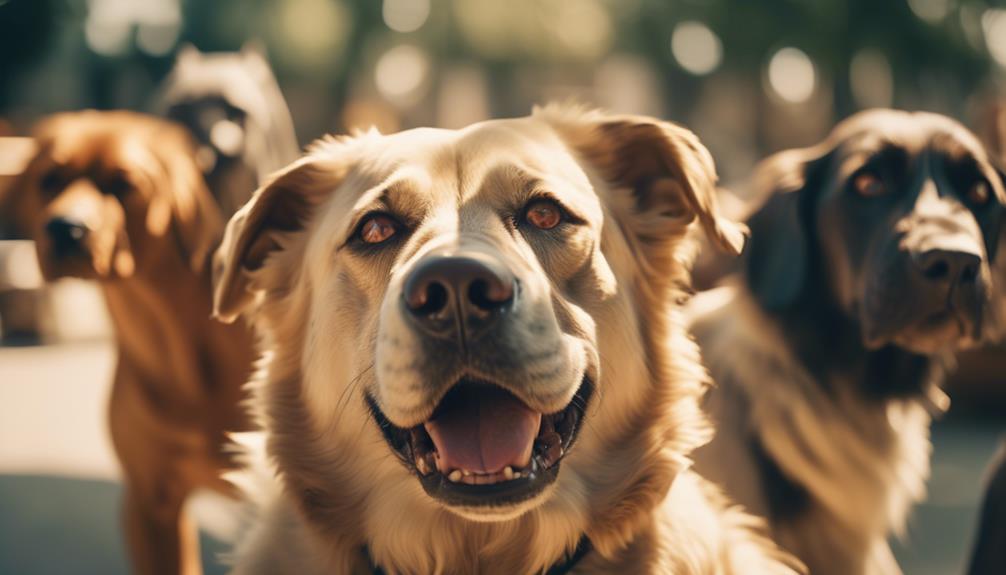How to Choose a Dog If You Live in a Hot Climate

Tips for Choosing a Dog in a Hot Climate:
Find a breed with short hair and a tolerance for heat, such as a Chihuahua or a Dalmatian.
Make sure to provide plenty of shade and water to keep your furry friend cool and comfortable.
Key Takeaways
- Short-furred breeds with light-colored coats and long noses are better equipped to handle the heat in hot climates.
- Dogs with lean builds have a higher surface area-to-volume ratio for efficient heat dissipation.
- Breeds with moderate activity levels and efficient cooling mechanisms are suitable for exercise in hot weather.
- Dogs with short, single-layered coats and thin hair are better equipped to handle hot weather.
Consider the Climate
In hot climates, it's crucial to consider the specific needs of a dog when choosing the right breed. The weather can have a significant impact on a dog's well-being, especially in hot weather. When it comes to hot climates, breeds with short fur are more suitable as they're better equipped to handle the heat. Short coats provide better heat dissipation, allowing the dog to regulate their body temperature more efficiently.
Additionally, light-colored coats reflect sunlight, helping to keep the dog cooler. It's also important to consider a breed's physical characteristics. Dogs with long noses and lean builds have better heat tolerance as they can pant more effectively, allowing for greater air circulation and cooling. On the other hand, breeds with thick, dense fur may struggle in hot weather, as their coats can trap heat. Similarly, brachycephalic breeds, with their short snouts, may have difficulty breathing and cooling themselves in extended periods of hot weather.
It's essential to monitor dogs with heat-sensitive characteristics closely, as they're more susceptible to heat exhaustion or heatstroke. Providing plenty of water and shade is crucial to ensure their well-being in hot climates.
Research Heat Tolerance

Considering the specific needs of a dog in hot climates, researching heat tolerance is crucial when selecting the right breed. To help create a mental image of the factors to consider, here are two sub-lists:
Physical Attributes:
- Short Coats: Breeds such as Australian Cattle Dogs, American Hairless, and Italian Greyhounds have shorter coats that provide less insulation, making them more comfortable in hot weather.
- Lean Builds: Dogs with lean body types, like the Mexican Hairless Dog and the Chinese Crested, tend to have a higher surface area-to-volume ratio, allowing for more efficient heat dissipation.
- Light-Colored Fur: Breeds like the Italian Greyhound, Yorkshire Terrier, and Pharaoh Hound often have lighter-colored fur, which reflects sunlight and reduces heat absorption.
Regional Origins:
- Australian Outback: Breeds like Australian Cattle Dogs have adapted to the hot conditions of the Australian outback, making them well-suited for hot climates.
- Natural Adaptations: Dogs originating from warm regions, such as the Mexican Hairless Dog and the Pharaoh Hound, may possess inherent adaptations that help them cope with heat.
Assess Exercise Needs

To ensure that your dog can safely engage in outdoor activities in a hot climate, it is essential to assess their exercise needs. Different dog breeds have varying activity levels and heat tolerance, so it's important to find a dog that matches your exercise routine and can handle the warm weather. Consider breeds with moderate activity levels if you prefer a more relaxed exercise routine in hot weather. Additionally, look for breeds with heat-tolerant traits such as short coats, lean builds, and efficient cooling mechanisms.
Here is a table that provides information on some of the best dog breeds for hot weather:
| Breed | Activity Level | Heat Tolerance |
|---|---|---|
| Labrador Retriever | High activity level | Moderate heat tolerance |
| Greyhound | Medium activity level | High heat tolerance |
| Boxer | High activity level | Moderate heat tolerance |
| Chihuahua | Low activity level | High heat tolerance |
| Australian Cattle Dog | High activity level | High heat tolerance |
Evaluate Coat Type

Evaluate the coat type of a dog to determine its suitability for hot weather conditions. When choosing a dog for a hot climate, it's important to consider the breed's coat type. Here are some factors to consider:
- Short, single-layered coats: Dogs with short coats that don't trap heat are well-suited for hot weather. These coats allow for better air circulation and prevent overheating.
- Light-colored coats: Breeds with light-colored coats, such as white or light tan, reflect sunlight, helping to keep them cool under the sun's rays.
- Thin, sleek coats: Dogs originating from hot regions like Africa or the Mediterranean often have thin, sleek coats that are well-adapted to warm climates. These coats provide insulation without causing excessive heat retention.
- Hairless or short, smooth coats: Hairless breeds or those with short, smooth coats are better equipped to handle hot weather. Without the extra fur, they're less likely to overheat during outdoor exercise.
To make sure your dog stays comfortable in a hot climate, avoid breeds with thick, dense fur designed for cold weather. These breeds, such as Great Danes with their flowing locks or dogs with double coats, may struggle to regulate their body temperature in high temperatures.
Size Matters

When selecting a dog for a hot climate, the size of the breed should be taken into consideration. Different dog breeds have varying height and weight ranges, which can impact their ability to handle hot temperatures. Smaller breeds, such as the Chihuahua, Italian Greyhound, and Chinese Crested, are generally more suited for hot weather due to their size. These breeds were historically bred to hunt and have adapted to thrive in warm climates.
In addition to their size, certain physical characteristics can also help dogs stay cool in hot temperatures. Brachycephalic dogs, or dogs with short noses, are more prone to heat exhaustion and should be avoided in hot climates. On the other hand, dogs with upright ears have better air circulation, helping them regulate their body temperature more effectively. Dogs with a short coat, like the Whippet or the Boxer, are also more comfortable in hot weather as they don't retain as much heat.
Furthermore, dogs with a deep chest, such as the Greyhound, have a larger lung capacity, allowing for improved airflow and heat dissipation. This helps them stay cool and comfortable even in hot conditions.
Considering the size of the breed, as well as other physical characteristics, is crucial when choosing a dog for a hot climate. By selecting a breed that's well-suited for hot weather, you can ensure that your furry companion remains happy and healthy in your warm environment. These breeds, known for their adaptability and resilience, make excellent choices for those living in hot climates.
Look for Cooling Mechanisms

Consider breeds with short coats, light-colored fur, or hairless varieties that are better at dissipating heat when selecting a dog for a hot climate. Dogs need to take the heat into account, and choosing a breed with cooling mechanisms can help them withstand hot temperatures. Here are some factors to consider when looking for breeds with effective cooling mechanisms:
- Short Coats: Breeds with short coats, such as the Boxer or the Dalmatian, have fur that doesn't trap heat, allowing them to stay cool more easily.
- Light-Colored Fur: Light-colored fur reflects sunlight, helping to keep the dog's body temperature down. Dogs with light-colored fur, like the Samoyed or the Maltese, can handle the heat better.
- Hairless Varieties: Hairless breeds, such as the Chinese Crested or the Xoloitzcuintli, have no fur to trap heat. Their lack of hair allows them to dissipate heat more efficiently.
Seek Professional Advice

Professional advice from a veterinarian or animal behaviorist is essential when selecting a dog breed for a hot climate. These experts can provide valuable insights into the specific needs and suitability of different dog breeds in relation to hot weather conditions. When seeking professional advice, it's important to consult with individuals who've experience in dealing with dogs in similar climates. For instance, breed-specific rescue organizations or experienced dog breeders can offer valuable information on the adaptability of certain breeds to hot weather.
A veterinarian or animal behaviorist can guide you in understanding the grooming needs, exercise requirements, and potential health issues related to hot climates for specific dog breeds. They can help identify breeds that make great companions in hot climates due to their ability to regulate body heat effectively. Dogs with thin hair or those that come in a variety of colors can better dissipate heat.
Additionally, professionals can help you keep an eye out for potential heat-related challenges and advise on necessary precautions to ensure the well-being of the dog.
Frequently Asked Questions
What Is the Best Dog for Hot Climate?
The best dog for a hot climate varies based on factors such as shedding, activity levels, and tolerance to heat. Breeds like Australian Cattle Dogs and Italian Greyhounds are well-suited, but research and consultation with a vet are recommended.
What Dog Breeds Don't Do Well in Heat?
Certain dog breeds, such as those with thick coats or shortened snouts, may struggle in hot climates due to heat intolerance and breathing difficulties. Providing shade, water, and modifying exercise routines can help keep them comfortable and prevent heatstroke.
What Climate Is Too Hot for Dogs?
Living in a hot climate can be challenging for dogs. Heatstroke prevention is vital, so provide shade, cooling techniques, and ample hydration. Watch for signs of heat exhaustion and adjust outdoor activities accordingly.
How Do Dogs Survive in Hot Climates?
Dogs survive in hot climates by utilizing cooling techniques such as panting and seeking shade. Hydration is crucial in hot weather to prevent heat-related illnesses. Signs of heatstroke include excessive panting and lethargy. It's important to groom dogs appropriately and provide access to water and shade.









